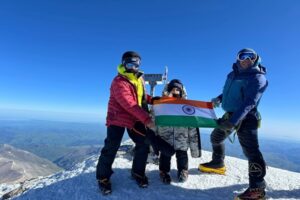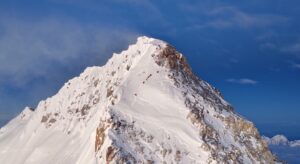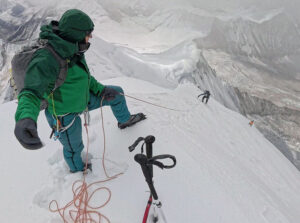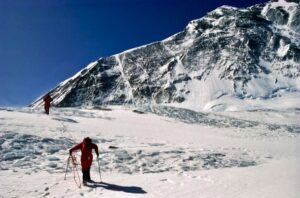Climbers on commercial expeditions will no longer have to “prove” their summits through an interview with The Himalayan Database.
For 60 years, the non-profit has recorded nearly every summit from 160 Nepal peaks, but will now stop interviewing team members and leaders from expeditions climbing the normal routes. Instead, they will “concentrate on new and interesting routes on the 8,000’ers and other commercial peaks, as well as new and technically challenging mountains that are climbed in Alpine style in the Nepal Himalaya,” they stated in a press release yesterday.
Too many to track
The decision is not surprising. As they note, things have changed a great deal since the Himalayan Database founder Elizabeth Hawley started her famous interviews with the 1963 American Everest expedition led by Norman Dyhrenfurth. At the time, there was only one permit issued for each mountain per season; this spring, Nepal’s Department of Tourism issued 1,176 permits to foreigners climbing Nepal peaks, 478 of them for Everest.
“There are so many individual climbers with different outfitters nowadays, it is no longer possible [for the seven-member team] to chase them the way we chased them during Miss Hawley’s time,” Billi Bierling told ExplorersWeb.

Billi Bierling and the late Elizabeth Hawley some years ago. Photo: Billi Bierling
“Back in those days, we used to ring the trekking agents to find out who was arriving when, and where they were staying,” Bierling explained. “We would then ring the hotel as soon as we thought the climbers would have arrived from the airport and arrange a meeting for the next day. We would speak to the climbers before and after their expeditions.”
“I feel sad that we had to do this [stop interviewing every climber]. However, if we tried to continue our work in the ‘Liz Hawley style’, we would have to employ a team of 100 people and would still not be able to keep up,” Bierling said.
Looking for the alpinists
“What we will focus on in the future are interesting or new routes on commercial mountains, such as Kilian Jornet’s attempt on the Hornbein Couloirs in Alpine style on Everest this season. We will look at noteworthy climbs on mountains aside from the 8,000’ers, preferably in Alpine style, and anything else that does not take place in a hugely commercialized way. Cutting the interviews with everyone who attempts a commercial route on a commercial mountain also means that we will have more time to do in-depth interviews with alpinists who make mountaineering history in Nepal,” Bierling explained.

Kilian Jornet photographed from Everest’s Camp 2, with the west flank of Everest in the background. Photo: Kilian Jornet
Still willing to talk
The team will still record summits from commercial 8,000’er expeditions, but these will be based on the lists provided by Nepal’s Ministry of Tourism. The ministry’s staff rarely require summit proof and don’t note the use of helicopters.
The team will happily talk with teams who ask for an interview. “If someone, who has just climbed Everest wants to tell us their tale, we spare no effort to meet them and listen, or give them a ring if we are not in Kathmandu. We even have a form they can fill in,” Bierling told us. “We will also continue to do sporadic interviews and meet expedition leaders with larger teams as this will give us a good overview of the season.”

Climbers can still submit their climbing reports to The Himalayan Database through a form accessible through this QR code.
“We also welcome any hints and corrections to our data. The truth deserves to be told, just like Elizabeth Hawley emphasized in her career,” the team noted in their press release.
How about the use of O2?
An interesting question is what will happen to those climbing without O2, especially on Everest.
“As far as no-O2 ascents on Everest are concerned, we will definitely try and speak with them. Most people will post about this amazing achievement on social media,” Bierling said. “To me, climbing Mount Everest without supplemental oxygen is still an amazing feat which only the best can do.”

Tenjen Sherpa “Lama”, on Cho Oyu’s summit this year. Photo: Kristin Harila
On lower 8,000m peaks, no-O2 climbs were not supposed to be anything extraordinary, but rather the norm.
“It is interesting to note that peaks like Cho Oyu (the sixth highest mountain in the world at 8,201m) were traditionally almost exclusively climbed without supplemental oxygen,” Bierling said. “The number of no-O2 ascents of Cho Oyu is still higher than the number of ascents with oxygen (2,414 without O2 vs. 1,519 with O2), and the same applies to Dhaulagiri 1, for example (395 without O2 vs. 257 with O2).”
“This was also the case with Manaslu but, as commercial expeditions have used Manaslu as a training peak for Everest, the number of O2 ascents overtook the number of no-O2 ascents a few years ago,” Bierling said. “Though it has become an exception to climb even the lower 8,000’ers without O2, looking back at history, this style of climbing used to be the norm.”






